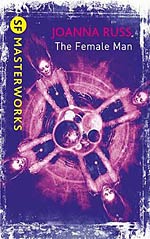
![]() couchtomoon
couchtomoon
2/17/2015
![]()
"Everyone knows that much as women want to be scientists and engineers, they want foremost to be womanly companions to men (what?) and caretakers of childhood; everyone knowsthat a large part of a woman's identity inheres in the style of her attractiveness." [60]
"Laura is daydreaming that she's Genghis Khan." [60]
Joanna Russ' 1975 turbulent treatise on female oppression, The Female Man, begs for interaction from the reader. It taunts with its candor. Even as a forty-year-old book, it dares you to disagree. For the modern reader of this not-really-tale, side effects may include chest tightening "buts," understanding "ohs," and flustered "oh come ons."
In a recent article with ShelfAwareness.com, Kim Stanley Robinson describes Russ' The Female Man as the "Book that made me laugh the hardest while slapping me in the face." He couldn't be more precise.
The lives of four women collide: the uber-feminine doormat Jeannine, the rough-and-tumble person Janet, the agro-reactionary murderer Jael, and the rational, scholarly Joanna, our dear author, who communicates her own internal arguments and confusions via these four women. On the face of it, the women are presented as coming from four alternate worlds, but one infers quickly that the characters are non-entities, and that Russ is essentially arguing with herself, and with society, via these personalities. She conveys a divided female psyche that despises the status quo, yearns for gender equality, yet doesn't want to annoy people, and feels guilty for achieving her own version of equality by essentially giving up her femininity in the academic world.
Four women. Four J names. Different facets of Russ. Different facets of womanhood. Sometimes the narrator refers to "the Weak One" and we don't know who that is. Is it Jeannine, the young and naïve girly girl, who wants ever so much to get married, but for some reason she won't? But she's the quickest to accept and justify violence.
Uncertainties like that define the relative amorphousness of this novel. Its structure is as fractured as the author's identity, with chapters ranging in length from one sentence to one paragraph to ten pages. Storylines bounce to and fro, interrupted by personal statements, poems, anecdotes, and uncomfortable revelations about self and society.
This is a book of harsh truths, stylized in biting, provocative, funny ways:
In 1975, Russ reminds us, "There are more whooping cranes in the United States of America than there are women in Congress." [61]
She takes on marriage: "You can't imbibe someone's success by fucking them" [65]
She discusses social conditioning:
There is the vanity training, the obedience training, the self-effacement training, the deference training, the dependency training, the passivity training, the rivalry training, the stupidity training, the placation training. How am I to put this together with my human life, my intellectual life, my solitude, my transcendence, my brains, and my fearful, fearful ambition? ...You can't unite woman and human any more than you can unite matter and anti-matter... [151]
She posits a world without men by introducing Janet, from Whileaway, which is ten centuries ahead in an alternate future, where men have been long ago wiped out by way of disease: "And about this men thing, you must remember that to me they are a particularly foreign species; one can make love with a dog, yes?" [33]
Russ' witty cantankerousness is hard to put down, even if some of her references feel outdated to younger readers. Her portrayal of a typical party includes inane social chatter that illuminates the patronizing gender games people play ("His Little Girl" and "Ain't It Awful"), which seems ridiculous to this late-born Gen-Xer, who hopes no one still talks that way today. It's hard to believe people ever talked that way.
[But then again, one episode of Mad Men traumatized me, so I may be a little insulated. I may read old fogey SF, but I'll never watch that show again.]
Even if some of her portrayals might not quite mesh with today, enough truths bubble up to make this a relevant and influential discourse on gender relations. The majority of women I encounter still view marriage as a goal and career, their identities exist through their kids, and the career gap is still gaping.
But most compelling about this novel is the intimacy Russ shares. She splays out her soul, a psychic vivisection for the world to see. Blood pumping, heart beating, eyes agape, and mouth roaring. Sometimes it's too much and we feel embarrassed for her. Its cringe-inducing roughness is a little too roar-full. Younger generations like myself may balk at the more extreme portrayals of casual sexism, or find this mid-century roaring tiresome. (Women of my generation don't roar. We death-stare. Much more effective.) Most surprising for me is realizing that this was written only four years before I was born. I was born into this society???
But even if society has progressed beyond the immobile social roles of Russ' generation, and even if younger generations can't completely relate to the society Russ depicts, The Female Man still gives us kernels of familiar insidiousness that peek out from the corners. Today, social media has allowed us to see more brash displays of dangerous misogyny, but it's the subtle sexism that's most overlooked, and easiest to ignore. Russ reminds us of those places where our standards have been calloused, where our vigilance has waned.
Although The Female Man is a product of its time, we are not quite living in its desired legacy. This should be required reading for all. We should never become comfortable enough to allow this novel to be forgotten.
http://couchtomoon.wordpress.com